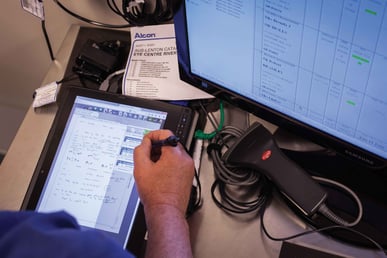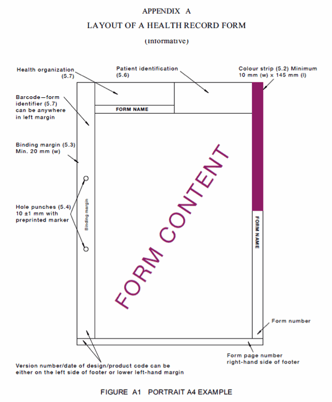A quick guide to AS2828 requirements for digital medical records

AS2828 is a standard containing 2 parts. Part 1 relates to the format of paper based patient health records and part 2 relates to digitised or scanned health records.
At first glance AS2828.1 appears to relate only to paper records, however the standard has implications for those who are considering moving to a digital medical records system.
The main reason for this is that part 2 stipulates that when documents are printed from a digital system, the physical print output must meet the standard's requirements. This is decribed in AS2828.2 section 4.7.6, where it states that the printed form should comply with the requirements of part one of the same standard:-
"4.7.6 Printing
If the digitized health record is reconstituted to paper format it should align with the record
layout and format as depicted in AS 2828.1, e.g. each printed page should clearly define the
form name, identification details and patient ID details. It is also recommended that page
numbers are included in printed footers or headers for ease in handling."
So what are the implications of AS2828 for a digital medical record?
To answer that, let's first take a look at some of the requirements of the standard:-
The figure below shows the layout of how a medical record should look. There are a number of mandatory requirements:
 Barcode Form identifier – digital medical records systems will need to record and manage a form identifier and represent it in barcode format.
Barcode Form identifier – digital medical records systems will need to record and manage a form identifier and represent it in barcode format.- Binding margin – designed to provide unrestricted view of the document when it is bound.
- Document version number, form number and page number – Quality management document control.
- Form name (in 2 locations) – displayed so it can be viewed from a portrait and landscape view.
- Health Organisation identification – who you are.
- Color strip – Color categorisation (we will look at this in detail shortly).
- Patient identification - a minimum set of demographics required to identify a patient.
The standard states that the form be color coded with a color strip positioned as per the above diagram. The colors are derived from a list contained in the standard that attribute each color to a particular document category. The standard defines a number of categories, but organisations can determine their own categories and colors (must be Pantone) as long as they are recorded and the same categories always used.
 For example a category named ‘Consent and Legal’ would contain all your documents that would fall into that category and have the pantone color 525U. This means that your digital medical records system will need to be able to accept categories and colors from the standard and apply them to relevant documents.
For example a category named ‘Consent and Legal’ would contain all your documents that would fall into that category and have the pantone color 525U. This means that your digital medical records system will need to be able to accept categories and colors from the standard and apply them to relevant documents.
If your records management system does not support colour coding you will need to resort to printing blank templates that you can feed into a printer when printing your completed documents. A considerable logistical effort not to mention the room for error that could occur printing the wrong form onto the wrong template.
Conclusion
To be truly effective and meet the current standard, medical records systems need to be able to manage the document template design and all its required components. Morever it needs to support document categories and form colour coding forms with pantone standard colors. Finally your system must support portrait and landscape print versions of the document standard.
When considering a digital medical records system I recommend you look at systems that can provide seamless compliance to AS2828 straight out the box.
The Digital Medical records systems your are considering may have terrific functionality, but unless it prints documents that meet the standard, it won't be compliant and accreditation time becomes so much harder.
The standard is available form SAI Global



